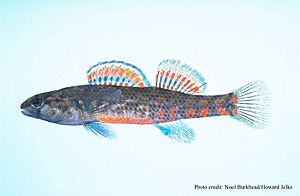Gulf darter facts for kids
Quick facts for kids Gulf darter |
|
|---|---|
 |
|
| Gulf darter (Etheostoma swaini) | |
| Conservation status | |
| Scientific classification | |
| Synonyms | |
|
The gulf darter (Etheostoma swaini) is a type of ray-finned fish that lives in fresh water. It belongs to a group of fish called Etheostomatinae, which is part of the Percidae family. This family also includes well-known fish like perches.
You can find the gulf darter in states like Louisiana, Mississippi, Alabama, Florida, Tennessee, and Kentucky. It's a very colorful fish, especially the males. They have bright red-orange and blue-green stripes near their tail. These fish can grow to be about 7.8 centimeters (3.1 in) long.
Gulf darters usually live in small and medium-sized creeks. They often prefer very shallow water. They like areas with sandy bottoms and lots of water plants, like Sparganium americanum. They search for food among these plants and bits of leaves, eating insect larvae and other small creatures. The International Union for Conservation of Nature says the gulf darter is a species of "least concern". This means it's not currently in danger of disappearing.
Contents
What the Gulf Darter Looks Like
The gulf darter has a body that is a bit flat on the sides and strong. It has a small, cone-shaped head. Its gill membranes (the skin covering its gills) are slightly joined. It also has a wide frenum (a small fold of skin) on its upper lip.
On its back, the fish has about seven to nine faint, square-shaped marks. It also has a clear light stripe just before its dorsal fin (the fin on its back). Along its sides, you can see light and dark stripes. When it's time to mate, the male gulf darters become even more colorful. They show off bright red-orange and blue-green stripes that are strongest near their caudal fin (tail fin).
On average, gulf darters are about 5.3 centimeters (2.1 in) long. However, they can grow up to 7.8 centimeters (3.1 in) long.
Where Gulf Darters Live and Their Home
Gulf darters mostly live in small to medium-sized creeks. They prefer areas with sandy or sandy-muddy bottoms. You'll often find them near water plants or where there's a layer of leaves and other organic material.
These fish are found from Lake Pontchartrain, Louisiana, all the way east to the Ochlockonee River in Florida. They also live in many rivers that flow into the eastern side of the Mississippi River. This includes areas from Buffalo Bayou, Mississippi, north to the Obion River system in Tennessee and Kentucky. Gulf darters are often seen in very shallow spots, sometimes looking for food in water less than 5 centimeters (2.0 in) deep!
In most creeks, the gulf darter's favorite small home area (called a microhabitat) has a lot of water plants, especially Sparganium americanum. These fish actively search for food among the plants. They also use the calm spots behind these plant clumps to rest. In bigger creeks with lots of plants, they like quiet areas along the stream banks with sand or sand-silt bottoms. Sometimes, in the smallest creeks, you might find them in shallow, fast-moving areas called riffles, which are formed by logs, rocks, or plants. Gulf darters do not do well in salty or "brackish" water.
What Gulf Darters Eat and Who Eats Them
Gulf darters are insectivores, which means they mostly eat insects. They feed on small invertebrates (animals without backbones). Their diet includes things like black flies, mayflies, and dragonflies. Studies have shown that tiny fly larvae, especially chironomids, are a very important food source for gulf darters of all sizes.
The main predators (animals that hunt them) of the gulf darter are likely larger freshwater fish. These can include fish like burbots (Lota lota), stonecats (Noturus flavus), and smallmouth bass (Micropterus dolomieu). Like many other darter species, the gulf darter can hold its position on the bottom of the stream even in flowing water. This special ability helps it live in its preferred watery homes.
Gulf Darter Life Cycle
Gulf darters can live for up to about 35 months, which is almost three years. They mate during mid-February to late March. This usually happens when the water temperature is between 5.5 and 17.0 °C.
When it's time to mate, the fish gather on gravelly areas where the stream leaves a deeper pool. Once they choose their partners, the fish mate many times over several days. The female will lay about 90 eggs. After laying the eggs, the female will start to burrow into the gravel. She buries herself and the eggs to help protect them. During the breeding season, males often show territorial behavior. This means they will defend their chosen area from other fish.
Naming the Gulf Darter
The Gulf darter was first officially described in 1877 by an American biologist named David Starr Jordan. He gave the fish its scientific name. The place where the first specimen was found and described was a small stream that flows into the Pearl River near Monticello, Mississippi. The specific name of the fish, swaini, honors another biologist and colleague of Jordan's, Joseph Swain.
Protecting the Gulf Darter
Gulf darters might face threats from runoff and pollution. This can happen because of cities growing and developing nearby. For example, one study found that building a highway negatively affected the number of several fish species, including the gulf darter. This was because the highway construction lowered the water quality of a nearby creek.
Right now, there are no specific plans just for protecting the gulf darter. However, the number of these fish seems to be steady. It's a common species with many groups living in different places over a wide area. Because of this, the International Union for Conservation of Nature has said its conservation status is "least concern". This means it's not currently considered to be in danger.
See also
In Spanish: Etheostoma swaini para niños


